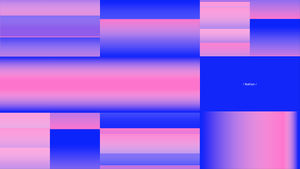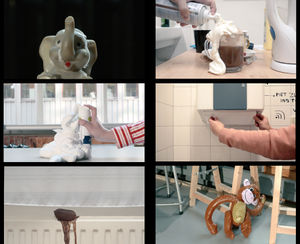1st draft
Abstract: My most current on going film project (untitled yet) focuses on communication issues on social media, it expands from my person experience to a wider range. In the following paragraphs, I will describe the structures of my work, which include the main content, future development and related practice.
I would like to describe what I am working on currently and the concept behind by the following paragraphs. How I made my current new film based on my WhatsApp chat history and how I transferred those texts into moving images. Moreover, the motivation that drove me to my current work, and the visible or invisible relations with my previous work and reading texts. Furthermore, to demonstrate my future research strands.
Motivated from my personal experience, I’m working on a looping abstract film. It is based on my WhatsApp chat histories with 8 friends with different culture backgrounds, the mutual fact of those friends is that we reply on online chat app to communicate with each other largely. I exported my chat histories and translated them from text to moving images for the main visual elements. The frequency in general is able to show the intimacy of an online chat relationship as well as it shows the gaps between conversations. Therefore, the synchronous point between those texts and moving images I applied to the film is the frequency of the chat, which is also defined by different time slots. The length of the film is 7 minutes, the length of my chat histories is 70 days, thus, I translated the physical time to the time within the film, which finally calculated as 6 seconds = 1 day chat. In the film, there’s a subtle timetable which describes my different start points and end points of chats in different time. Therefore, to simulate an abstract chat experience in the film. All the moving images are moved randomly due to the quantities and speed are generated from different chat frequencies, in that case, the visual can be translated and shown precisely from the real chat histories.
What motivate me very initially is the communication gaps between me and people from different cultures. It is well-known that online chat in digital age is not quite stable. In a way, it’s like fast food culture ( McDonald, KFC ), it takes an extremely short time to know a new person or friend through online chat apps. However, this communication usually is just about the surface and could be fragile. Therefore, like one time glove, people use it, ditch it. When a conversation is ended with or without specific reason, a new conversation could be started quite quickly via online chat apps. Back to my own experience, my connections on WhatsApp are mainly friends that I knew through social medias, by re-observing the conversations, I slowly see this film as a self-critical, self-identify, self-awareness project, when I’m in a new environment or community, online chat on one hand makes it simple and quick to know new people, on the other hand, I could abuse with this online chat convenient. It seems to be safer communicating with people behind the screen or mobile phone rather than talking to them in reality, thus, it forms an “Otaku” communication. However, this could be a common phenomenon by expanding from my personal experience to others. Therefore, I try to build the resonance between my personal experience with viewers about the communication issues, which include insecurity, frustration and irresponsibility.
In the current stage of my project, I need tutors to offer help to discuss the necessity for viewer to be aware of the film is generated from texts. More important is how if it’s necessary. The key point could be finding a way to interact with viewers. Additionally, I need help from musicians or music students for the sound track of the film.
It is totally different with my previous project: a short film <Unattributed Stimulations of Objects> technically. However, they are connected conceptually, which is desire. I filmed 6 different objects in different daily life scenes in <Unattributed Stimulations of Objects>, the film focuses on those objects and how they’re changed, distorted or destroyed by other objects which are utilized by human. Superficially, it’s about different objects and their different status, in fact, the way the status of those objects changes, twists implies human’s desire of controlling, violent, sexuality, etc. in a deeper meaning. In addition, those objects are mainly selected from daily life, such as: shaving cream, inflatable balloon, toilet towel, candles, ice cream, in the meanwhile, they are also quite easy to be ignored. In my current work - WhatsApp chat history visualization, using smartphone app to communicate and chat with each other has become a part of our/my daily life as well, I really enjoy the convenience digital technology and internet brought to me, however, what drives me to communicate with “strangers” on the internet? The motivation could be desire of escaping from reality, seeking for security, quick satisfaction of sexuality, etc. We swim in the internet ocean, chatting to each other is not only as simple as texts, it but also reflect each other’s desire like a mirror. In that case, this project is connected with my previous film project conceptually.
Sigrun , Catalina and Fabian helped me with shooting and setting with different daily life scenes for my previous work <Unattributed Stimulations of Objects>.
There are several readings that inspired and drove me to my current WhatsApp project. In Geert Lovink’s <What Is the Social in Social Media?>, he questioned what is “social” in today’s “social media”, do we unconsciously fear the day when our vital infrastructure breaks down and we really need each other? Why do we assemble these ever-growing collections of contacts? Will “friending” disappear overnight, like so many new media-related practices that vanished in the digital nirvana? He cited Andrew Keen’s critical warns about social media that Facebook, Google, etc. might be software cages to human, do we really feel less lonely in this digitalized connected world? In the thesis <Virtual Communities: networks of the future>, Albert Benschop also critics about virtual communication network. Is virtual community-building able to stop the fragmentation of social human relations? Additionally, he made comparisons between real life communication and communication in virtual community. There are certain advantages of online communication, such as: no mistaken ideas about the other person based on physical appearance; The ease of meeting each other; Equal access to the conversation for the participants. As well as the disadvantages : In mant cases appearance is important; Conversation should not only be based on efficiency; Some ideas are more useful than others. Moreover, I just started to read a related content, which is <The Masses: The Implosion of the Social in the Media> by Jean Baudrillard and Marie Maclean.
Conceptually, for my future work and research direction, I would like to continue focusing on the influence and interaction between digital culture, technology and me. Furthermore, to build a connection or resonance with a larger group. It is undeniable that internet and digital technology have made a variety of seems to be impossible things possible and reachable, our life has become efficient, convenient. In the meanwhile, what has been neglected might be patience, trust, security, privacy, etc. They are happening everyday in our life now, thus, forming the influence day by day in an invisible way, however, our behaviors and reactions could be visible. In Zach Blas’s work <Facial Weaponization Suite>, he collected facial data from different people and created different marks that represent different meanings: sexual orientation, racist issue, feminism and nationalist violence. These masks interest with social movements’ use of masking as an opaque tool of collective transformation that refuses dominant forms of political representation. (https://vimeo.com/57882032)
On the other hand, I’m also passionate about how digital media and technology bring us new impact and aesthetic visually, for instance: In Rainer Kohlberger’s film <Not Even Nothing Can Be Free Of Ghosts>, no motion pictures meet the retina, but impulses and waves of pure light instead. Through his experiments by creating film and moving images without any cameras, Rainer kolhberger provides audiences with powerful physical and metaphysical experiences, which go far beyond the usual ones in the cinema.
Technically, I would very much like to try real time performance, collaborate with different artists or musicians. Such as the A/V performance by COH & Tina Frank. (https://vimeo.com/139869283)
Bibliography:
Geert Lovink, [2012], <What Is the Social in Social Media?>.
E-flux journal, [2015],<The Internet Does Not Exist>.
Albert Benschop, [1997],< Virtual Communities: networks of the future >.
Jean Baudrillard and Marie Maclean, [1985], <The Masses: The Implosion of the Social in the Media>.
Sara Ahmed,[2010], <Happy Objects>.


